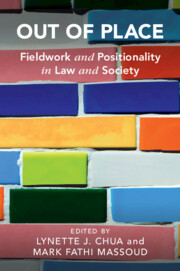Refine search
Actions for selected content:
59 results
Chapter 1 - Introduction
-
- Book:
- Historical Trauma
- Published online:
- 20 November 2025
- Print publication:
- 04 December 2025, pp 1-10
-
- Chapter
- Export citation

Historical Trauma
- Psychological Processes, Contexts, and Healing
-
- Published online:
- 20 November 2025
- Print publication:
- 04 December 2025
Chapter 7 - Social Work in Need of Activism
- from Part I - Storying-to-Learn: How Stories-that-Matter Help Us Appreciate Social Work in Action
-
-
- Book:
- Learning through Social Work Stories-That-Matter
- Published online:
- 28 August 2025
- Print publication:
- 11 September 2025, pp 92-109
-
- Chapter
- Export citation
Death of the Gharīb: A Window towards a Regional Understanding of Displacement in the Middle East
-
- Journal:
- Comparative Studies in Society and History / Volume 67 / Issue 4 / October 2025
- Published online by Cambridge University Press:
- 17 July 2025, pp. 761-784
-
- Article
-
- You have access
- Open access
- HTML
- Export citation
Co-design of interventions and services with structurally marginalized populations in the context of maternal and early childhood primary care: a rapid scoping review
-
- Journal:
- Primary Health Care Research & Development / Volume 26 / 2025
- Published online by Cambridge University Press:
- 16 June 2025, e48
-
- Article
-
- You have access
- Open access
- HTML
- Export citation
Chapter 37 - Reflections of a Developmental Psychologist from India
-
-
- Book:
- Pillars of Developmental Psychology
- Published online:
- 14 February 2025
- Print publication:
- 20 February 2025, pp 421-433
-
- Chapter
- Export citation
4 - The Origins of Criminalized Governance
-
- Book:
- Inside Criminalized Governance
- Published online:
- 06 February 2025
- Print publication:
- 13 February 2025, pp 97-135
-
- Chapter
- Export citation
Selecting the Number of Classes Under Latent Class Regression: A Factor Analytic Analogue
-
- Journal:
- Psychometrika / Volume 70 / Issue 2 / June 2005
- Published online by Cambridge University Press:
- 01 January 2025, pp. 325-345
-
- Article
- Export citation
The Weight on Her Shoulders: Marginalization of Women Legislators in Parliaments and Substantive Representation of Women
-
- Journal:
- British Journal of Political Science / Volume 54 / Issue 4 / October 2024
- Published online by Cambridge University Press:
- 27 November 2024, pp. 1340-1361
-
- Article
-
- You have access
- Open access
- HTML
- Export citation
Chapter 2 - Thriving within Ourselves: Epistemic Injustice and Individual Wellness
-
-
- Book:
- How People Thrive
- Published online:
- 14 November 2024
- Print publication:
- 21 November 2024, pp 37-64
-
- Chapter
- Export citation
12 - Chronic Social Exclusion, Radicalization, and Extremism
- from Part III - Topics Related to the Exclusion–Extremism Link
-
-
- Book:
- Exclusion and Extremism
- Published online:
- 16 May 2024
- Print publication:
- 23 May 2024, pp 263-286
-
- Chapter
- Export citation
11 - Rejection and Serious Aggression
- from Part III - Topics Related to the Exclusion–Extremism Link
-
-
- Book:
- Exclusion and Extremism
- Published online:
- 16 May 2024
- Print publication:
- 23 May 2024, pp 239-262
-
- Chapter
- Export citation

Out of Place
- Fieldwork and Positionality in Law and Society
-
- Published online:
- 11 March 2024
- Print publication:
- 22 February 2024
-
- Book
-
- You have access
- Open access
- Export citation
Chapter Seven - At Odds with Everything around Me
-
-
- Book:
- Out of Place
- Published online:
- 11 March 2024
- Print publication:
- 22 February 2024, pp 139-159
-
- Chapter
-
- You have access
- Open access
- HTML
- Export citation
Chapter Five - Feeling at Home Outside
-
-
- Book:
- Out of Place
- Published online:
- 11 March 2024
- Print publication:
- 22 February 2024, pp 103-118
-
- Chapter
-
- You have access
- Open access
- HTML
- Export citation
Chapter Two - Research as Accompaniment
-
-
- Book:
- Out of Place
- Published online:
- 11 March 2024
- Print publication:
- 22 February 2024, pp 36-56
-
- Chapter
-
- You have access
- Open access
- HTML
- Export citation
Preface
-
- Book:
- Out of Place
- Published online:
- 11 March 2024
- Print publication:
- 22 February 2024, pp xiii-xvi
-
- Chapter
-
- You have access
- Open access
- HTML
- Export citation
Chapter Four - Out of Place when Studying China’s Sex Industry
-
-
- Book:
- Out of Place
- Published online:
- 11 March 2024
- Print publication:
- 22 February 2024, pp 84-102
-
- Chapter
-
- You have access
- Open access
- HTML
- Export citation
Chapter Nine - Becoming a Familiar Outsider
-
-
- Book:
- Out of Place
- Published online:
- 11 March 2024
- Print publication:
- 22 February 2024, pp 188-208
-
- Chapter
-
- You have access
- Open access
- HTML
- Export citation
Chapter Six - Out of Place in an Indian Court
-
-
- Book:
- Out of Place
- Published online:
- 11 March 2024
- Print publication:
- 22 February 2024, pp 119-138
-
- Chapter
-
- You have access
- Open access
- HTML
- Export citation
